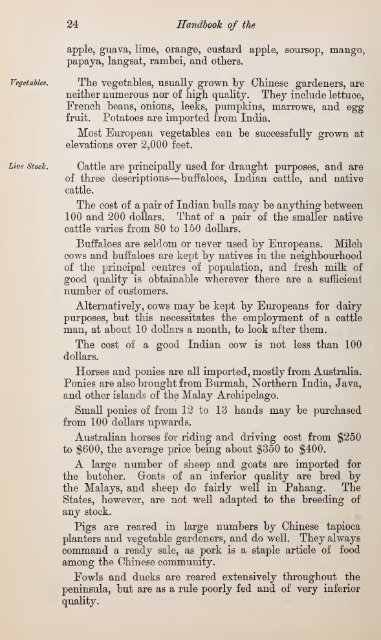Handbook of the federated Malay states - Sabrizain.org
Handbook of the federated Malay states - Sabrizain.org
Handbook of the federated Malay states - Sabrizain.org
You also want an ePaper? Increase the reach of your titles
YUMPU automatically turns print PDFs into web optimized ePapers that Google loves.
24 <strong>Handbook</strong> <strong>of</strong> <strong>the</strong><br />
apple, guava, lime, orange, custard apple, soursop, mango,<br />
papaya, langsat, rambei, and o<strong>the</strong>rs.<br />
Vegetables. The Vegetables, usually grown by Chinese gardeners, are<br />
nei<strong>the</strong>r numerous nor <strong>of</strong> high quality. They include lettuce,<br />
French beans, onions, leeks, pumpkins, marrows, and Qg^<br />
fruit. Potatoes are imported from India.<br />
Most European vegetables can be successfully grown at<br />
elevations over 2,000 feet.<br />
Live StocTc. Cattle are principally used for draught purposes, and are<br />
<strong>of</strong> three descriptions—buffaloes, Indian cattle, and native<br />
cattle.<br />
The cost <strong>of</strong> a pair <strong>of</strong> Indian bulls may be anything between<br />
100 and 200 dollars. That <strong>of</strong> a pair <strong>of</strong> <strong>the</strong> smaller native<br />
cattle varies from 80 to 150 dollars.<br />
Buffaloes are seldom or never used by Europeans. Milch<br />
cows and buffaloes are kept by natives in <strong>the</strong> neighbourhood<br />
<strong>of</strong> <strong>the</strong> principal centres <strong>of</strong> population, and fresh milk <strong>of</strong><br />
good quahty is obtainable wherever <strong>the</strong>re are a sufficient<br />
number <strong>of</strong> customers.<br />
Alternatively, cows may be kept by Europeans for dairy<br />
purposes, but this necessitates <strong>the</strong> employment <strong>of</strong> a cattle<br />
man, at about 10 dollars a month, to look after <strong>the</strong>m.<br />
The cost <strong>of</strong> a good Indian cow is not less than 100<br />
dollars.<br />
Horses and ponies are all imported, mostly from Australia.<br />
Ponies are also brought from Burmah, Nor<strong>the</strong>rn India, Java,<br />
and o<strong>the</strong>r islands <strong>of</strong> <strong>the</strong> <strong>Malay</strong> Archipelago.<br />
Small ponies <strong>of</strong> from 12 to 18 hands may be purchased<br />
from 100 dollars upwards.<br />
Australian horses for riding and driving cost from $250<br />
to $600, <strong>the</strong> average price being about $350 to $400.<br />
A large number <strong>of</strong> sheep and goats are imported for<br />
<strong>the</strong> butcher. Groats <strong>of</strong> an inferior quality are bred by<br />
<strong>the</strong> <strong>Malay</strong>s, and sheep do fairly well in Pahang. The<br />
States, however, are not well adapted to <strong>the</strong> breeding <strong>of</strong><br />
any stock.<br />
Pigs are reared in large numbers by Chinese tapioca<br />
planters and vegetable gardeners, and do well. They always<br />
command a ready sale, as pork is a staple article <strong>of</strong> food<br />
among <strong>the</strong> Chinese community.<br />
Eowls and ducks are reared extensively throughout <strong>the</strong><br />
peninsula, but are as a rule poorly fed and <strong>of</strong> very inferior<br />
quality.

















